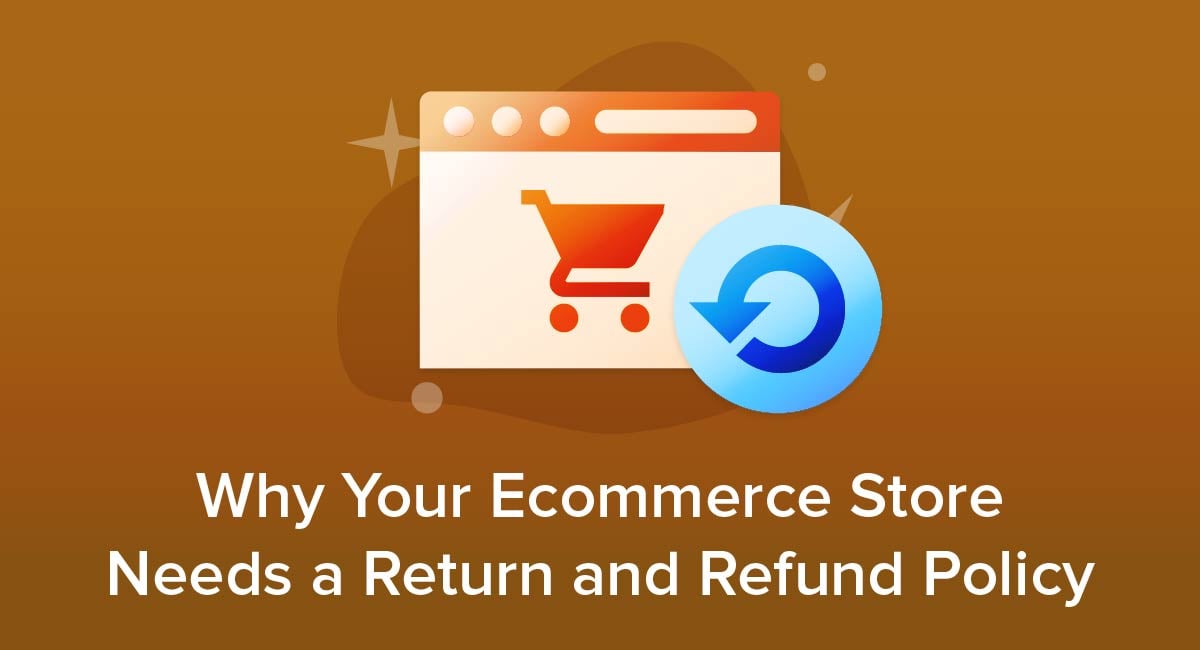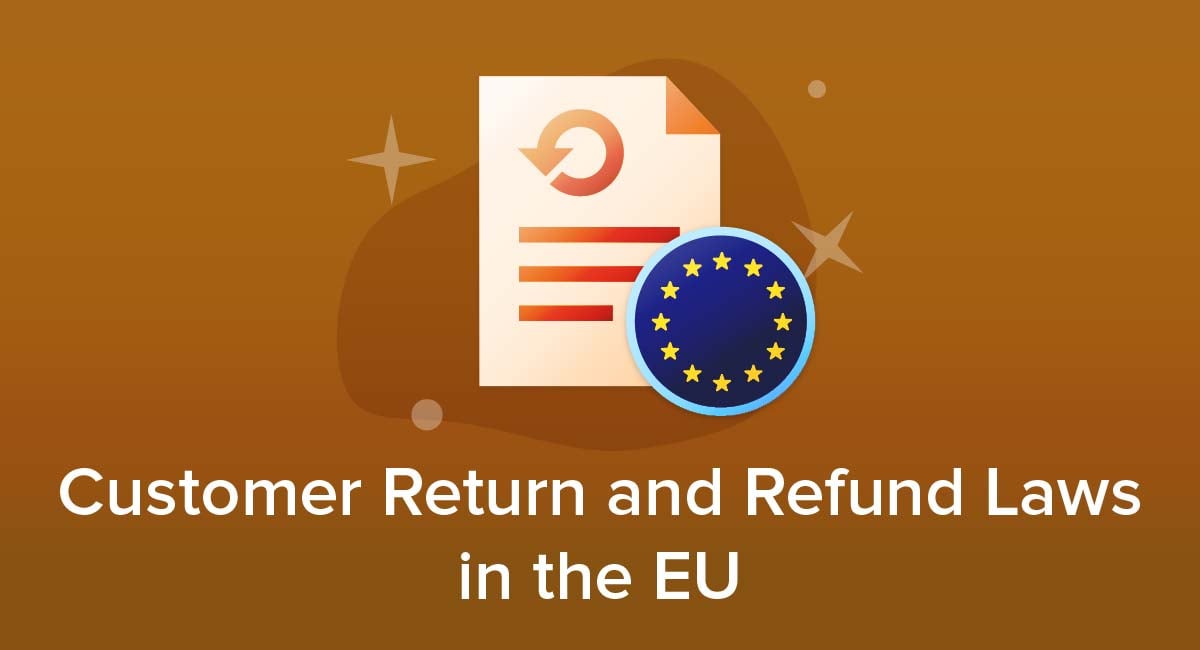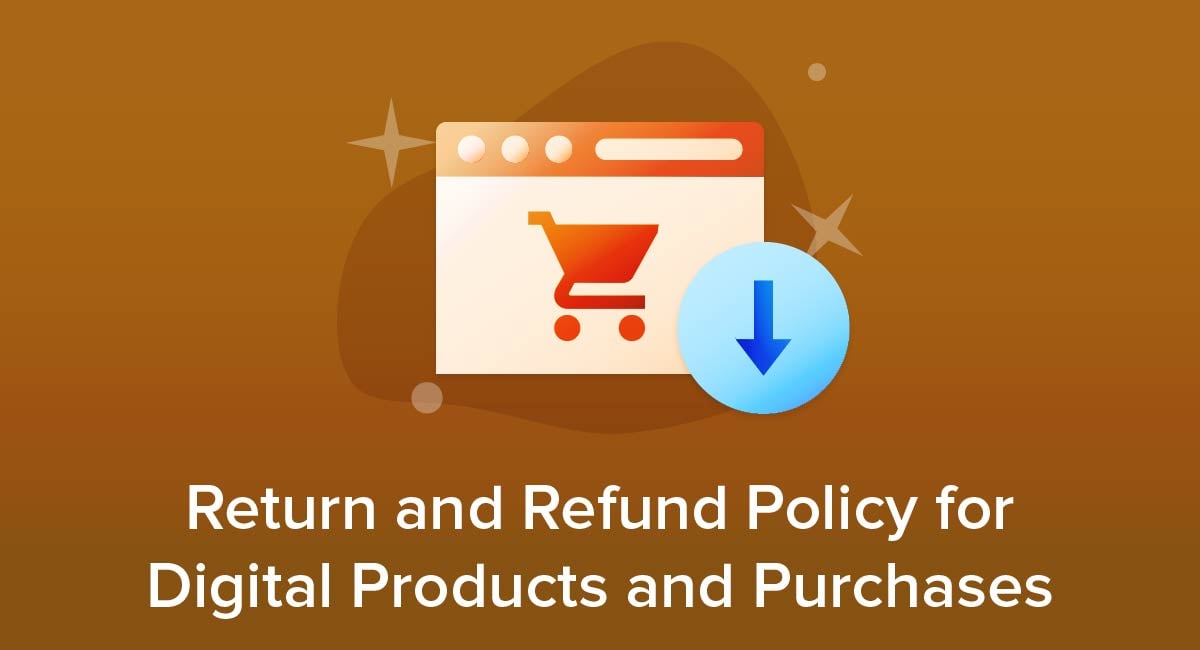
Selling digital products has different technical implications than selling physical products, but you still need to think about your Return and Refund Policy. Making clear when and how you accept returns and offer refunds will keep customers informed while protecting your legal position. A clear policy will gain customer trust and cut the time you have to spend addressing invalid refund and return requests.
Here's what you need to know about why you should have a Return and Refund Policy if you sell digital products, how to create one, and how to display it.
Use FreePrivacyPolicy.com to generate the necessary legal agreements for your website/app:
- Free Privacy Policy Generator
- Free Terms and Conditions Generator
- Free Cookies Policy Generator
- Free Disclaimer Generator
- Free EULA Generator
- Free Return & Refund Policy Generator
You check our Free Cookie Consent to start making your business legally compliant with the Cookies Directive in the EU.
- 1. What is a Return and Refund Policy for Digital Products and Purchases?
- 2. Is a Return and Refund Policy for Digital Products and Purchases Legally Required?
- 3. Are There Reasons Other Than Laws Why I Would Need a Return and Refund Policy?
- 4. What Should You Include in a Return and Refund Policy for Digital Products and Purchases?
- 4.1. No Returns or Refunds
- 4.2. How to Request a Refund
- 4.3. Timeframe for Requesting Refunds
- 4.4. Timeframe and Method for Receiving Refunds
- 4.5. How Subscriptions are Handled
- 4.6. Disclose Any Processing Fees
- 4.7. Exceptions to the Policy
- 5. How Should You Display Your Return and Refund Policy for Digital Products and Purchases?
- 6. Summary
What is a Return and Refund Policy for Digital Products and Purchases?
A Return and Refund Policy clearly sets out when and how you accept returns and issue refunds. Just as importantly, it explicitly or implicitly tells customers when you do not accept returns or issue refunds.
Remember that "no refunds" or "all sales are final" is a form of a Return and Refund Policy.
You need to cover all these points for digital products in exactly the same way as you would with physical products. The main difference is that you may need to give more specific instructions about how to "return" a product when it is something that the customer can't physically take to a store or mail to your warehouse.
Is a Return and Refund Policy for Digital Products and Purchases Legally Required?
Whether a Return and Refund Policy is legally required varies in different countries and jurisdictions. Let's break down some key points.
If products are faulty or not as advertised, you must accept returns and offer refunds in most jurisdictions.
With non-faulty products in the United States, the specific rules vary between different states. Most states fall into two categories:
- You don't have to accept returns and issue refunds
- The default is that you must offer returns and issue refunds in some circumstances. Having a policy of not accepting returns can override this, but the policy must be conspicuous and readable by the customer before they make a purchase.
For sales to customers in the European Union, you must normally accept refunds and issue returns during the 14 days after purchase. Some digital products such as tickets and downloaded goods are exempted.
Strictly speaking, the law doesn't require a Return and Refund Policy, though you must give customers enough accurate information to enable them to make an informed buying decision. This would include telling them about any restrictions or requirements in your returns process.
The United Kingdom has broadly the same rules as the European Union.
Canadian law doesn't require you to accept returns and issue refunds for non-faulty goods. Customers do have the right to get your Return and Refund Policy in writing.
Always check the relevant laws in your country.
Are There Reasons Other Than Laws Why I Would Need a Return and Refund Policy?
Yes. First, you will likely lose business if you don't have one, as customers may see you as untrustworthy or not be willing to spend money on a product they may ultimately not be satisfied with.
Secondly, you may need a Return and Refund Policy to meet the requirements of any distribution service for digital products. For example, Google handles return/refund requests made by customers within 48 hours of purchase through the Google Play store. App developers are responsible for handling requests after this time, and for dealing with complaints about faulty apps. Google doesn't say what to include in your return/refund policy but says you can set one.
Here are additional reasons why having a Return and Refund Policy is a smart choice:
- It reduces the time you spend dealing with invalid return/refund requests from people who incorrectly assumed they could return a product.
- It reduces the risk of ambiguity and legal dispute.
- It lets you impose restrictions on how and when people can return products.
- It lets you set out specific rules for specific situations such as differentiating between physical and digital products.
- It gives clarity to potential customers who may be more willing to make a purchase if they feel confident they can get a refund if necessary.
- It shows you are confident your products are good quality and meet customer needs.
What Should You Include in a Return and Refund Policy for Digital Products and Purchases?
Your Return and Refund Policy should tell customers when and how they can return digital goods and, just as importantly, when they can't. Here are some key points to cover.
No Returns or Refunds
If you do not accept returns or issue refunds, say so clearly. Remember that a blanket "no returns" policy usually can't apply to faulty products or those which are not as advertised.
Physical Kitchness makes clear it offers no returns or refunds:
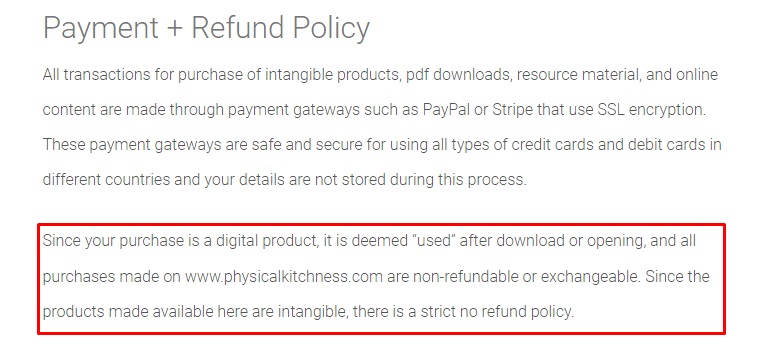
How to Request a Refund
Explain what customers must do to initiate a refund request. Give clear details such as a link to an online form or the email address they must use.
With physical goods, you would normally explain where customers must take or send the products. With digital goods, you instead need to explain what customers must do as part of the "return." This could mean simply no longer accessing a service. It could also mean uninstalling an app or computer software.
Amazon gives clear instructions for how to return a Kindle book:
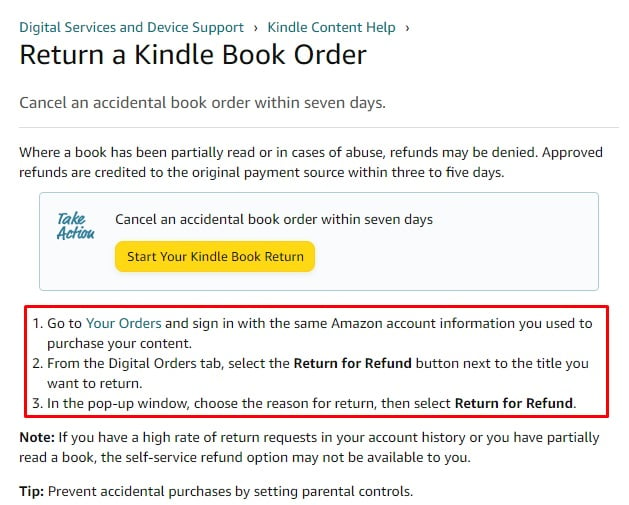
Digital Documents Direct explains what users must do as part of the refund process:
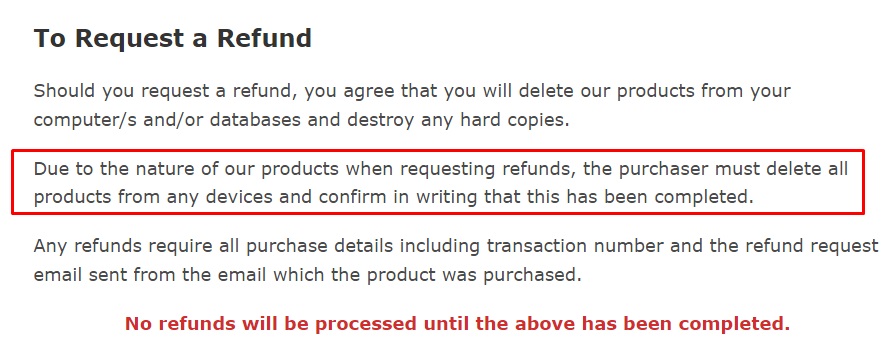
Timeframe for Requesting Refunds
Clearly list any deadlines that apply to refunds. Explain when any time period begins, such as the customer having 30 days from installation to request a refund. Also make it clear how long a refund will take to process.
Meta sets out clear timelines for when users can request a refund and how long it takes to process the request:
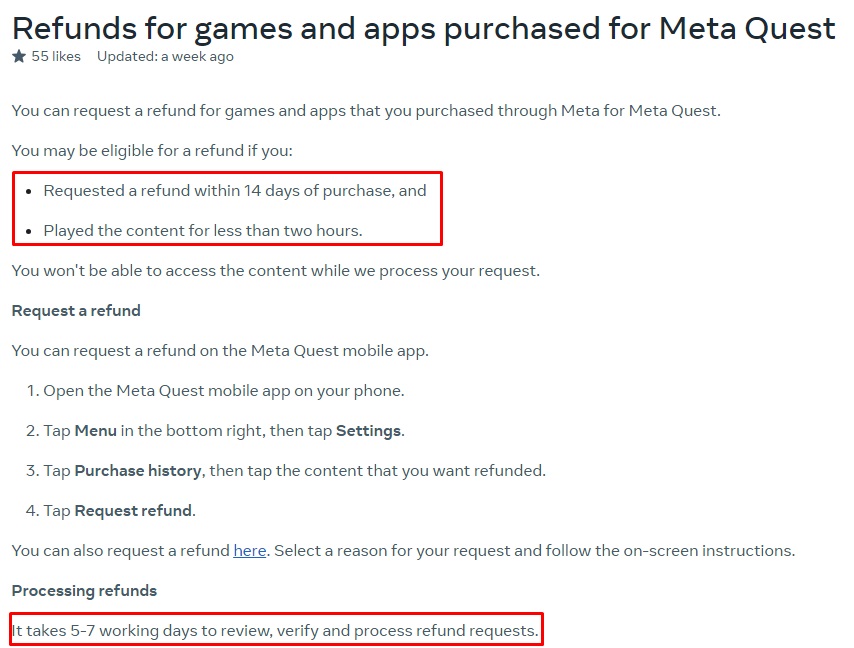
Timeframe and Method for Receiving Refunds
Say when the customer will receive a refund and the method of repayment. This could be a refund to the original payment card, virtual store credit, an electronic gift card, or a check in the mail.
Mega Digital makes clear how customers will receive a refund:

How Subscriptions are Handled
Set out any special rules if you run a digital subscription service. This could include only offering a partial refund, based on how long the customer accessed the service.
Microsoft explains its rules for Xbox subscription cancellations and refunds:

Disclose Any Processing Fees
Say whether you deduct any fees when issuing a refund, for example to cover processing. Remember that you might not be able to charge these fees if the return is of a faulty product rather than the customer simply changing their mind.
360 Digital Marketing explains that it deducts both fixed and time-related fees:
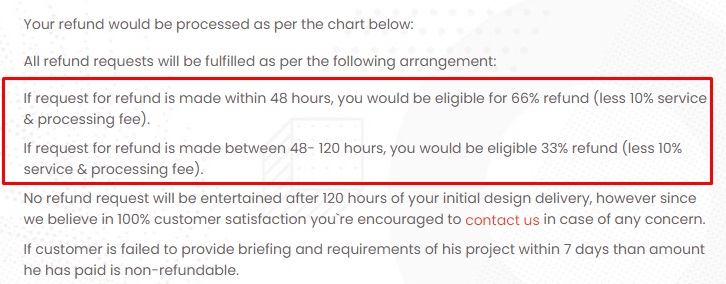
Exceptions to the Policy
Detail any exceptions to your normal policy. With digital products this could include tickets or software that the customer has already used to create something. You could also exclude products the customer has "consumed" in full, for example a single movie purchase rather than a monthly streaming service.
Take-Two details situations where refunds are not allowed:
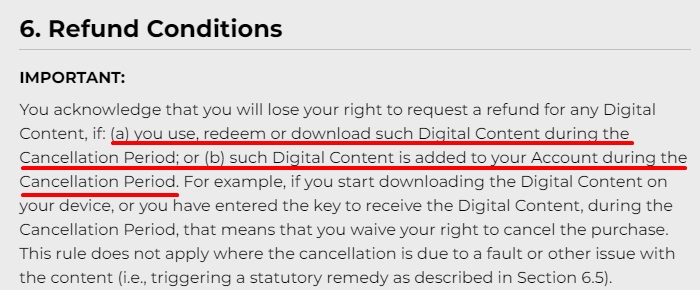
How Should You Display Your Return and Refund Policy for Digital Products and Purchases?
Make your Return and Refund Policy as clear and prominent as possible. As well as being the right thing to do to build trust and customer relations, this may be necessary for the policy to have legal force. Some jurisdictions only allow policies limiting returns and refunds if they are prominent.
Most laws which have specific, objective requirements on presenting Return and Refund Policies refer to printed documents shown in physical locations. With digital products, this is rarely the case. Instead, you'll instead need to follow a principle: the customer should have a reasonable opportunity to see and read the Return and Refund Policy before making a purchase.
It's also good practice to make sure they can review the Return and Refund Policy later on, for example when they need to request a refund.
The best option is to include your Return and Refund Policy on your website as a separate page, linked in the site's footer.
Here's an example:
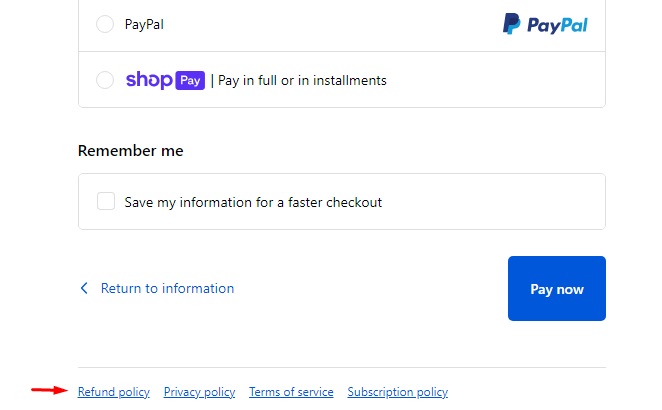
For added legal certainty, you can require the customer to confirm they have read and understood the Return and Refund Policy.
Premier Photo Booth has a mandatory drop-down menu to confirm agreement to the Refund Policy:
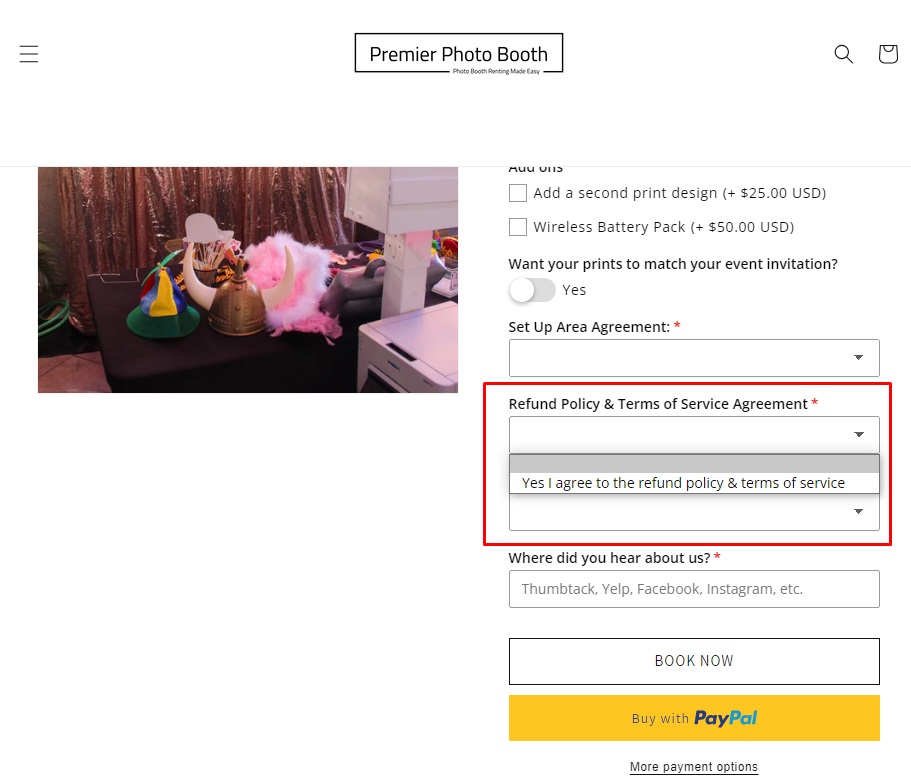
Summary
You need a clear Return and Refund Policy for digital products and purchases just as much as with physical products.
In some jurisdictions, a Return and Refund Policy is the only way to limit or refuse returns. App stores and other software distribution services may also have rules on your Return and Refund Policy.
A Return and Refund Policy can also say when you do not accept returns. The key is to make it clear.
Your policy should say when and how customers can ask for refunds, when and how you'll issue refunds. what exceptions or fees apply and anything the customer must do such as uninstall software.
Present your Return and Refund Policy clearly and prominently so customers can see it before and after a purchase. The best option is a dedicated web page, clearly linked to your site's footer.
